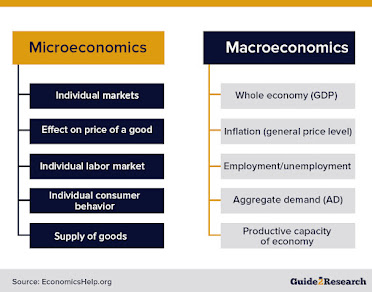In earlier
article, we got information about basics of economics. Now take look at its
type.
Economics is divided into two main parts:-
· Micro economics
· Macro economics
Micro Economics
The term micro leads to the meaning of small. The
term micro economics derived from the Greek word ‘mikros’ which means
‘small’. According to prof. Boulding who
was a well-known economist in past years says that “Microeconomics is the study
of particular firms, a particular household, individual price, wages, income,
individual industries, and particular commodities.” In other words, it states that
this firm of economics deals with small-scale calculations. In this
economics, we study individuals rather than the whole nation we emesis on a
small unit of it. This is mainly used for industries that are independent of
others.
For example, when we talk about microeconomics
we study about finance department of the government rather than the whole money sector.
In simple terms, we give more attention to a small or particular unit of any
country, nation’s government, or industry. When we study about Gujarat
government on the scale of Indian government than it calls microeconomics.
We mainly study the following in
microeconomics:-
· Product
pricing
· Consumer
behavior
· Factor
pricing
· Economic
condition of a section of the people
· Study
of particular firms
· Location
of industry
Thus, when we are studying how to producer
fixes the prices of his products, we are studying Micro-Economics. Similarly,
when we are studying why the industry is located at a particular place, we are studying
Micro-Economics.
Macro Economics
The term Macro leads to large. The term Macro
Economics derived from the Greek word ‘makros’, meaning ‘large’. It is the study of
overall economic phenomena or the economy of the whole, rather than its individual
parts. According to Mc Connel, “Macroeconomics examines the forest and not the
trees. Thus it analyses and establishes the functional relationship between
large aggregates.” In other words, this firm of economics study and calculate
about big or at large scale. Thus, in Macro-Economics, we study the economic behavior
of the large aggregates such as the overall condition of the economy such as
total production, total saving, and total investment.
For example, in Macroeconomics we study the whole
expenses of government as a whole unit not by dividing it into small units
like finance or any other sector. Or in a simple way, we look after the whole company
rather than going for a particular firm or department.
It includes:-
· National
income and output
· General
price level
· Balance
of trade and payments
· External
value of money
· Saving
and investment
· Employment
and economic growth
Thus, when we study why we continue to have
balance of payments deficits, or why the value of rupee vis-à-vis dollar is
falling or why saving rates are high or low in a particular country, we are
studying Macro-Economics.
It may be noted that the classification of
economics into Micro and Macro-economics is purely for analytic purposes.
In fact, there is really no opposition between
micro and macroeconomics. Both are absolutely vital and in most cases, they play
a complementary role, E.G. national income can’t grow unless the product in individual
firms and factories rises.
It is difficult to distinguish between the two
terms as belonging to water-tight compartments. What macro from the national
standpoint is micro from the world point of view. Similarly, what is micro from
a national angle becomes macro from the regional angle. Unless we define what is
the whole we cannot say about phenomena whether it is micro and macro.
reference: From book General Economics by The institute of chartered Accountants' India.






Bhai deaign karvi hoi to keje
ReplyDeleteWhen you will bring an article on swish bank ? I'm keen to know that one.
ReplyDelete